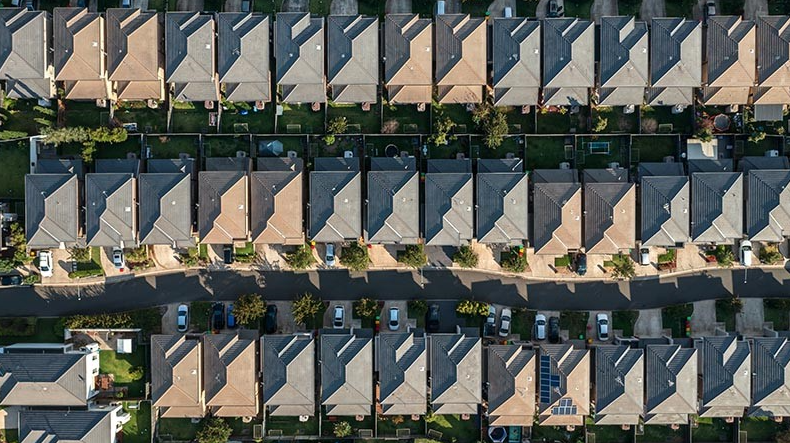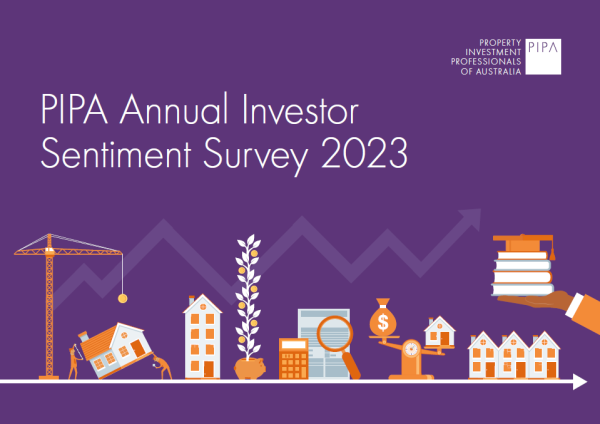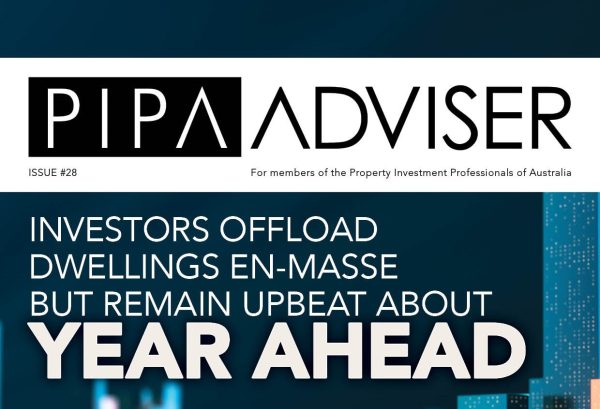PIPA National Market Update – July 2023
Jul 2023Karen Millers
Categories
Location ReportsMedia releasesNational market updatesPersonal advisersPIPA AdviserPIPA Annual Investor Sentiment SurveysPIPA Member ProfilesPIPA video updatesPIPA webinarsPodcastsProperty advisersProperty newsLatest Articles
Location Report – City of Geraldton
Which property cycle are we in?
Rent rises ease but crisis’ link to population density found to be tenuous
Jordan van den Berg: The ‘Robin Hood’ TikToker taking on Australian landlords
Victorian property investors face yet another new property tax as council tests levy
Contrary to the plethora of poor property forecasters who predicted significant property price falls, market conditions continue to be solid in the face of the low supply of sales listings around the nation, according to the latest PIPA National Market Update.
This report pulls together insights and analysis from seven market experts and PIPA members from the latest edition of the PIPA Adviser e-magazine’s national market update.
PIPA Chair Nicola McDougall said the significant price falls simply did not materialise in many property markets – even with the most rapid increase in interest rates in a generation.
“Of course, part of the reason why prices have been strengthening is the significant number of overseas migrants – some half a million seemingly – who have landed on our shores within the past year or two, which is also causing rental markets to continue to struggle with a critical undersupply of stock,” she said.
Ms McDougall said as well as healthy market conditions, it appeared that the rising interest rate cycle may have come to an end.
“The Reserve Bank of Australia took its foot off the throttle in early July and held the cash rate steady at 4.1 per cent, which provided some confidence to property buyers around the nation,” Ms McDougall said.
“The June quarter inflation reading also came in well under market expectations at six per cent with it highly possible we are at, or near, the peak of the cash rate.”
NEW SOUTH WALES
Victor Kumar, Director, Right Property Group
“Despite expectations to the contrary, the New South Wales housing market has been quite resilient, proving yet again how wrong the doomsayers can be when trying to predict the largest and arguably the most stable market in the country.
“Despite rapid rate rises, and the so-called mortgage cliff(s), the market has carved itself into three distinct categories – the affordable, below $1.5 million corridors; the above $1.5 million areas; and the regionals.
“The everchanging landscape and dynamics is influenced by various factors such as economic conditions (read end of fixed rates and inflation), government policies, buyer preferences, and affordability. Compound that with a strong immigration factor, and we have a stabilisation of value despite the negative economic and affordability outlook.
“Selling agents that were expecting a whole raft of properties to hit the market, as they report fielding increasing calls for market appraisals, are still to bring these properties on the market.
“Owners struggle to rationalise selling their properties, as they cannot qualify for a new loan at the same or higher level under the current lending constraints, and renting is also a struggle, with a strong shortage in most areas.
“Construction starts are still, year on year, quite low, which will serve as a great buffer to the potentially softening prices, forcing to keep the price and rent trends still in an upward trajectory.
“In fact, the recent Master Builders Australia forecast shows a significant reduction (-3.1 per cent or circa $2 billion) in 2023, with the declining trend continuing in 2024, after the initial upswing in building starts in 2021 and 2022.
“Diving deeper into these stats paint an even grimmer picture, which is perhaps beyond the scope of this update.
“So, with all these moving parts, and conflicting data, especially when the data will also have to be seasonally adjusted for the new financial year traditional traders, the spring season sellers and the genuine “can’t hold on any mores”, where does the market really stand?
“From March to June, the NSW market has exhibited resilience, but I believe the true tell will come once more stock comes onto the market, which may lead to copy-cat sellers rushing to the market.”
VICTORIA
Miriam Sandkuhler, CEO and Buyers Agent, Property Mavens
“June proved to be a month of contrasts in the Victorian property market. The month started with talk of a fast rebound until the RBA spoiled the party with yet another rate rise.
“You can see the impact in Melbourne auctions with clearance rates bouncing around between a relatively high range of 75% to 79% to the more moderate 65% to73% range.
“CoreLogic’s data shows inner city areas with more ‘investor listings’ – based on the rental history of properties – recording stronger activity than others.
“What we witnessed is these suburbs are also benefitting from strong demand from first home buyers. Many of these young buyers have been spooked by talk of never-ending rent rises and decided to try and enter the affordable end of the market.
“While the outlook for interest rates remains uncertain, we can expect to see demand for affordable property flow through to suburbs with relatively low house prices, like Maidstone ($826,500), West Footscray ($900,000) and Maribyrnong ($928,500) amongst others.
“It’s been a little quiet in the winter in Melbourne’s inner ring, but we are seeing solid demand in bayside areas. Well positioned, two-bedroom units in suburbs like Elsternwick and Hampton have seen some good results as have three-bedroom family homes in Bentleigh and Moorabbin.
“The other areas which have been performing well are in the north east, think suburbs Viewbank and Macleod, and the northwest in suburbs like Keilor East.
“The ‘Peninsula’ south of Melbourne is continuing its strong run with several areas doubling in price over the last three years.
“Much of the demand is coming from buyers cashing in on Melbourne prices and buying up in districts like Red Hill and Somers, along with areas closer to the city like Mt Eliza. Unit prices on the Peninsula have also been on the move.
We’ve also seen some stand out results in Geelong recently with a few million dollar-plus sales.
“While a little uncertainty remains, our team are reporting agents are telling them there will be are plenty of opportunities for buyers in spring. Buyers, though, should get some professional advice and stick to investment-grade properties.”
QUEENSLAND
Meighan Wells, Founder, Property Pursuit Advisors
“Read some media publications and you will be told the Brisbane property market is cooling. I’m calling BS.
“First and foremost, anyone with more than five minutes’ experience in the industry knows there is no ‘Brisbane property market’. Just as there is no Australian property market.
“Yes, prices for cookie-cutter, oversupplied investor stock and low-grade properties are taking a hit. They had to. The investment fundamentals for these properties were never there but FOMO raised their attractiveness and artificially inflated their prices.
“But remove that rubbish from the mix and we’ve got a pretty big issue with under-supply and an increasing level of demand.
“At the heart of it, the Brisbane LGA is still severely undersupplied in certain locations for specific property types and demand is not abating. In my 20-plus years in the industry I’ve not seen supply so low. Remember I am talking about quality property in the Brisbane LGA.
“How have we got to this point? Years of short-term knee-jerk poor policy and amazing weather. Yes, I jest but, in all seriousness, people have been flocking to Queensland over the past two and a half years and no one is leaving.
“Pre-COVID, population fluctuations were common – people would come, and people would go. One of the common reasons for departure was to seek higher paying job opportunities interstate or overseas.
“But with the ability to secure well-paying corporate jobs that have work from home, or hybrid arrangements, the requirement to relocate away from the Sunshine State has disappeared.
“The challenge for quality established housing supply is that no-one is selling until they can buy something else. But no-one is leaving. We now have a bottle neck of owners who won’t sell until they can buy but can’t find anything to buy until someone leaves. And no-one is leaving! And around and around it goes.
“Our lead buyer’s agent, Nathan Wunsch, lined up to register for an auction on Wednesday night to bid for a local buyer – he and about 15 other bidders. A reasonable appraisal was $1.1 million but it sold under the hammer for an eye-watering $1.25 million.
“That is feet on the ground, real life experience. It certainly isn’t indicative of a softening market that is based on a wrapped up median price. That is an undersupplied highly competitive market that is under pressure from strong population growth and poor policy over the long term.
“If you are an owner, enjoy the ride. But if you are a buyer, you are still facing tough times.”
SOUTH AUSTRALIA
Katherine Skinner, Director, National Property Buyers
“The South Australian and Adelaide property market is still on its upward trajectory as it continues to see month on month growth with a further 0.9% increase in home values as at 31st May. This is the second consecutive month of value increase we have seen in the Adelaide market, which is showing no signs of wavering.
“With a 1.1% total growth over the past quarter, we are anticipating this number to rise when new figures are released in July. This is driven by the significant shortage in stock levels across the market, which is sitting at a 6% decrease from this time last year, and to put in perspective, is a total of 54.6% lower stock than in the same quarter 2019 pre-COVID in what we would deem a “normal market”.
“This downturn in quality stock has placed upward pressure on home values as demand is still high despite the RBA’s interest rate rises thus far. We aren’t anticipating a sharp shift in this trend in the short-term, if interest rates continue moving north, we would expect to see an increase in supply, albeit being somewhat insignificant compared to pre-COVID levels.
“We are in a unique situation in SA, where home owners aren’t selling their homes prior to securing a new home, and with the limited number of properties hitting the market, it means many are sitting tight for now. This is putting added pressure on the already tight rental market with vacancy rates sitting at a low 0.3% across the state.
“With rents increasing an average of 13% in the past 12 months, people are feeling the pinch as they compete for the limited number of rentals available each week.
“On the ground, we continue to see strong auction results in many locations across the metropolitan area with clearance rates sitting at 69%, which is the highest across the country last week.
“Strong activity is being felt in all areas with investors, home buyers and developers still out in force looking to capitalise on the growing market while still seeing great value in affordability with Adelaide being the third most affordable capital city behind Darwin and Perth currently.
“Combined with strong rental yields supported by the low vacancy rates, this is holding investors in good stead for ongoing performance and providing them with the confidence to press forward with a property purchase in the current market.”
WESTERN AUSTRALIA
Terry Ryder, Director, Hotspotting
“The status of Perth and Western Australia as the leading market jurisdiction in the nation was confirmed by the Winter 2023 edition of The Price Predictor Index – a Hotspotting report which ranks locations according to their trends with sales activity rather than prices.
“Although Sydney is grabbing the headlines nationally for rising prices, the smaller cities and their regional areas are the national leaders on market activity. Western Australia, South Australia, and Tasmania – headed by their capital cities Perth, Adelaide and Hobart – are the jurisdictions with the strongest market pulses.
“Perth and Regional WA have continued to deliver more areas with rising sales activity than anywhere else in the nation and Perth continues to be the nation’s strongest market.
“Seven out of 10 suburbs had positive rankings in our latest report, an improvement on the previous quarterly survey. The cheaper markets are the strongest although there is growth to be found across all market sectors.
“Perth has maintained its status as undoubtedly the nation’s busiest and most buoyant property market. Its situation has strengthened since our Autumn 2023 report three months ago, with more locations with positive sales activity trends and fewer suburbs with weak numbers.
“Perth’s strong sales activity record has maintained upward pressure on prices. SQM Research recorded an 11.5% increase in Perth’s house price index in the 12 months to May 2023.
“Regional WA is following Perth’s lead. Mandurah, which previously appeared to have passed its peak, has had a resurgence, while Bunbury, Geraldton and Mundaring all also having solid markets.
“The report featured our National Top 10 municipalities, which included four in WA – Canning, Gosnells, Stirling, and Mandurah – with the City of Gosnells winning our vote as ‘The National Growth Star’.
“It may not be fashionable and it’s certainly not upmarket, but the Gosnells is a standout for attracting strong buyer demand – because it offers affordability in an area with good amenities. In simple terms, it’s what the mainstream buyer is looking for, whether they’re home-buyers or investors.
“Of the nine Gosnells suburbs in our analysis, eight have positive rankings (four rising, three consistency and one recovering). Most of these locations have median house prices in the $300,000s and $400,000s, providing a level of affordability that Melbourne and Sydney residents can only dream about – and it’s attracting investors from the eastern states in large numbers.”
TASMANIA
Simon Pressley, Head of Research, Propertyology
“One of the longest property market growth cycles ever experienced by Australian cities ended in Hobart in past two years. It was buyer fatigue more so than fundamentals that applied the brakes.
“Bearing in mind that it was Tasmania’s strong economy that drove the real estate growth, the outlook for its economy remains solid.
“Demand for the state’s world class agriculture, numerous unique tourism experiences and education are staples which will continue to underpin the economy.
“Moving forward, demand for housing will be supported by economic growth coming from infrastructure investment, some massive renewable energy projects, a few government facilities, transport infrastructure along with game-changing investment in stadiums and entertainment precincts.
“In the state’s north-west, there’s a $50 million new university campus at Burnie, a technology and innovation hub, JMC Group’s new CBD hotel, and Supto’s $20 million dairy manufacturing plant.
“The proposed $5.4 billion investment in two of Australia’s biggest renewable energy projects (Robbins Island wind farm and Marinus Link cable across Bass Strait) is unprecedented revenue for a community the size of Burnie.
“The state’s biggest-ever road infrastructure project, the $770 million Bridgewater Bridge, is now under way. Other Hobart projects include doubling the capacity of Australia’s 9th busiest airport, UTAS projects include a $400 million STEM hub plus a $130 million commerce hub in the CBD, and Nystar is investing $350 million into a new zinc plant.
“I personally believe that the recent funding announcement of the $750+ million development of a world class stadium with a roof, underpinning Tasmania entering a team in the AFL competition, will prove to be the most significant infrastructure project in the state’s history. The somewhat controversial project relates to much more than just a football team.
“In the state’s north, projects in the Australia’s fourth oldest city include a $344 million development of a new Launceston university. This facility is adjacent to UTAS Stadium, which is also slated for a $208 million redevelopment.
“There is $270 million being invested into a new correction facility at Westbury, upgrades to the Launceston hospital, $75 million on highways, JAC Group’s Gorge hotel project and plans to repurpose the former university site in the northern suburb of Newman.
“While current buyer activity volumes are underwhelming, housing supply across Tasmania remains low. With the economic outlook being so positive, the fundamentals for the treasure trove down under remain very solid.”
ENDS
Bricks & Mortar Media | media@bricksandmortarmedia.com.au | 0417 793 447
About PIPA
Property Investment Professionals of Australia (PIPA) is a not-for-profit association established by industry practitioners with the objective of representing and raising the professional standards of all operators involved within property investment.




